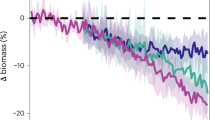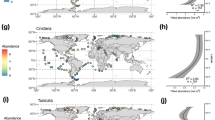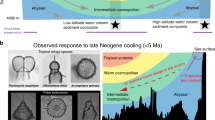Abstract
Marine plankton have been conspicuously affected by recent climate change, responding with profound spatial relocations and shifts in the timing of their seasonal occurrence. These changes directly affect the global carbon cycle by altering the transport of organic material from the surface ocean to depth, with consequences that remain poorly understood. We investigated how distributional and abundance changes of copepods, the dominant group of zooplankton, have affected biogenic carbon cycling. We used trait-based, mechanistic models to estimate the magnitude of carbon transported downward through sinking faecal pellets, daily vertical migration and seasonal hibernation at depth. From such estimates for over 200,000 community observations in the northern North Atlantic we found carbon flux increased along the northwestern boundary of the study area and decreased in the open northern North Atlantic during the past 55 years. These changes in export were primarily associated with changes in copepod biomass, driven by shifting distributions of abundant, large-bodied species. Our findings highlight how recent climate change has affected downward carbon transport by altering copepod community structure and demonstrate how carbon fluxes through plankton communities can be mechanistically implemented in next-generation biogeochemical models with size-structured representations of zooplankton communities.
This is a preview of subscription content, access via your institution
Access options
Access Nature and 54 other Nature Portfolio journals
Get Nature+, our best-value online-access subscription
$29.99 / 30 days
cancel any time
Subscribe to this journal
Receive 12 digital issues and online access to articles
$119.00 per year
only $9.92 per issue
Buy this article
- Purchase on Springer Link
- Instant access to full article PDF
Prices may be subject to local taxes which are calculated during checkout





Similar content being viewed by others
Data availability
Data generated to support the findings of this study are available within the paper and its supplementary information files.
References
Sigman, D. M. & Boyle, E. A. Glacial/interglacial variations in atmospheric carbon dioxide. Nature 407, 859–869 (2000).
Sanders, R. et al. The biological carbon pump in the North Atlantic. Prog. Oceanogr. 129, 200–218 (2014).
Steinberg, D. K. & Landry, M. R. Zooplankton and the ocean carbon cycle. Ann. Rev. Mar. Sci. 9, 413–444 (2017).
Stamieszkin, K. et al. Size as the master trait in modeled copepod fecal pellet carbon flux. Limnol. Oceanogr. 60, 2090–2107 (2015).
Turner, J. T. Zooplankton fecal pellets, marine snow, phytodetritus and the ocean’s biological pump. Prog. Oceanogr. 130, 205–248 (2015).
Hays, G. C. Zooplankton avoidance activity. Nature 376, 650 (1994).
Hansen, A. N. & Visser, A. W. Carbon export by vertically migrating zooplankton: an optimal behavior model. Limnol. Oceanogr. 61, 701–710 (2016).
Steinberg, D. K. et al. Zooplankton vertical migration and the active transport of dissolved organic and inorganic carbon in the Sargasso Sea. Deep Sea Res. Part I Oceanogr. Res. Pap. 47, 137–158 (2000).
Al-Mutairi, H. & Landry, M. R. Active export of carbon and nitrogen at Station ALOHA by diel migrant zooplankton. Deep Sea Res. Part II Top. Stud. Oceanogr. 48, 2083–2103 (2001).
Ohman, M. D. & Romagnan, J.-B. Nonlinear effects of body size and optical attenuation on Diel Vertical Migration by zooplankton. Limnol. Oceanogr. 61, 765–770 (2016).
Dahms, H. U. Dormancy in the Copepoda—an overview. Hydrobiologia 306, 199–211 (1995).
Brun, P., Payne, M. R. & Kiørboe, T. A trait database for marine copepods. Earth Syst. Sci. Data 9, 99–113 (2017).
Jónasdóttir, S. H., Visser, A. W., Richardson, K. & Heath, M. R. Seasonal copepod lipid pump promotes carbon sequestration in the deep North Atlantic. Proc. Natl Acad. Sci. U. SA 112, 12122–12126 (2015).
Visser, A. W., Grønning, J. & Jónasdóttir, S. H. Calanus hyperboreus and the lipid pump. Limnol. Oceanogr. 62, 1155–1165 (2017).
Bradford-Grieve, J. M. Potential contribution that the copepod Neocalanus tonsus makes to downward carbon flux in the Southern Ocean. J. Plankton Res. 23, 963–975 (2001).
Richardson, A. J. et al. Using continuous plankton recorder data. Prog. Oceanogr. 68, 27–74 (2006).
Johns, D. G. Raw data for copepods in the North Atlantic (25-73N, 80W-20E) 1960–2014 as recorded by the Continuous Plankton Recorder (2016); https://doi.org/10.7487/2016.250.1.1007
Beaugrand, G., Edwards, M. & Legendre, L. Marine biodiversity, ecosystem functioning, and carbon cycles. Proc. Natl Acad. Sci. USA 107, 10120–10124 (2010).
Sundby, S., Drinkwater, K. F. & Kjesbu, O. S. The North Atlantic Spring-Bloom System—where the changing climate meets the winter dark. Front. Mat. Sci. 3, 28 (2016).
Martinez, E., Antoine, D., D’Ortenzio, F. & de Boyer Montégut, C. Phytoplankton spring and fall blooms in the North Atlantic in the 1980s and 2000s. J. Geophys. Res. 116, C11029 (2011).
Chivers, W. J., Walne, A. W. & Hays, G. C. Mismatch between marine plankton range movements and the velocity of climate change. Nat. Commun. 8, 14434 (2017).
Poloczanska, E. S. et al. Global imprint of climate change on marine life. Nat. Clim. Change 3, 919–925 (2013).
Edwards, M. & Richardson, A. J. Impact of climate change on marine pelagic phenology and trophic mismatch. Nature 430, 881–884 (2004).
Greene, C. & Pershing, A. J. The response of Calanus finmarchicus populations to climate variability in the Northwest Atlantic: basin-scale forcing associated with the North Atlantic Oscillation. ICES J. Mar. Sci.1536–1544 (2000).
Chust, G. et al. Are Calanus spp. shifting poleward in the North Atlantic? A habitat modelling approach. ICES J. Mar. Sci. 71, 241–253 (2013).
Cermeño, P. et al. The role of nutricline depth in regulating the ocean. Proc. Natl Acad. Sci. USA 105, 20344–20349 (2008).
Palomares-Garcia, R. J., Gomez-Gutierrez, J. & Robinson, C. J. Winter and summer vertical distribution of epipelagic copepods in the Gulf of California. J. Plankton Res. 35, 1009–1026 (2013).
Guidi, L. et al. Plankton networks driving carbon export in the oligotrophic ocean. Nature 532, 465–470 (2016).
Boyd, P. W. Toward quantifying the response of the oceans’ biological pump to climate change. Front. Mar. Sci. 2, 1–15 (2015).
IPCC Climate Change 2014 Impacts, Adaptation, and Vulnerability (eds Field, C. B. et al.) 411–484 (Cambridge Univ. Press, 2014); https://doi.org/10.1017/CBO9781107415379.011.
Kiørboe, T. & Hirst, A. G. Shifts in mass scaling of respiration, feeding, and growth rates across life-form transitions in marine pelagic organisms. Am. Nat. 183, E118–E130 (2014).
R. Core Team. R: A Language and Environment for Statistical Computing (R Foundation for Statistical Computing, 2013); http://www.R-project.org/.
Locarini, R. A. et al. World Ocean Atlas 2013, Volume 1: Temperature (NOAA Atlas NESDIS 73, Silver Spring, MD, USA, 2013).
Rayner, N. A. et al. Global analyses of sea surface temperature, sea ice, and night marine air temperature since the late nineteenth century. J. Geophys. Res. 108, 4407 (2003).
Kostadinov, T. S., Milutinović, S., Marinov, I. & Cabré, A. Carbon-based phytoplankton size classes retrieved via ocean color estimates of the particle size distribution. Ocean Sci. 12, 561–575 (2016).
Schmidtko, S., Johnson, G. C. & Lyman, J. M. MIMOC: a global monthly isopycnal upper-ocean climatology with mixed layers. J. Geophys. Res. Ocean. 118, 1658–1672 (2013).
Amante, C. & Eakins, B. W. ETOPO1 1 Arc-Minute Global Relief Model: Procedures, Data Sources and Analysis NOAA Technical Memorandum NESDIS NGDC-24 (National Geophysical Data Center, 2009); https://doi.org/10.7289/V5C8276M.
Jiang, H. & Kiorboe, T. The fluid dynamics of swimming by jumping in copepods. J. R. Soc. Interface. 8, 1090–1103 (2011).
Rue, H., Martino, S. & Chopin, N. Approximate Bayesian inference for latent Gaussian models by using integrated nested Laplace approximations. J. R. Stat. Soc. Ser. B (Statistical Methodol. 71, 319–392 (2009).
Blangiardo, M. & Cameletti, M. Spatial and Spatio-temporal Bayesian Models with R-INLA (Wiley, Chichester, UK, 2015).
Gilliam, J. F. & Fraser, D. F. Habitat selection under predation hazard: test of a mModel with foraging minnows. Ecology 68, 1856–1862 (1987).
Kiørboe, T. & Tiselius, P. T. Gut clearance and pigment destruction in a herbivorous copepod, Acartia tonsa, and the determination of in situ grazing rates. J. Plankton Res. 9, 525–534 (1987).
Wessel, P., Smith, W. H. F., Scharroo, R., Luis, J. & Wobbe, F. Generic mapping tools: improved version released. Eos, Trans. Am. Geophys. Union 94, 409–410 (2013).
Acknowledgements
We acknowledge the Villum foundation for support to the Centre for Ocean Life. Further support was received from the Gordon & Betty Moore Foundation through award no. 5479’ (T.K. and A.V.W.), the NSF GRFP grant no. DGE-1144205 (K.S.) and the European Union 7th Framework Programme (FP7 2007–2013) through grant no. 308299 (NACLIM) (M.R.P.). We thank the scientists at SAHFOS whose efforts over the years helped to establish and maintain the CPR survey and H. van Someren Gréve for the beautiful copepod illustration.
Author information
Authors and Affiliations
Contributions
P.B., K.S., A.W.V., M.R.P. and T.K. designed the study. K.S. developed the faecal pellet model. P.L. selected the taxa used and compiled the data. P.B. performed the analysis and prepared the manuscript with contributions and support from the other authors.
Corresponding author
Ethics declarations
Competing interests
The authors declare no competing interests.
Additional information
Publisher’s note: Springer Nature remains neutral with regard to jurisdictional claims in published maps and institutional affiliations.
Supplementary information
Supplementary Information
Supplementary Methods, Supplementary Results, Supplementary Discussion, Supplementary Figs. 1–10, Supplementary Tables 1–3 and Supplementary References
Rights and permissions
About this article
Cite this article
Brun, P., Stamieszkin, K., Visser, A.W. et al. Climate change has altered zooplankton-fuelled carbon export in the North Atlantic. Nat Ecol Evol 3, 416–423 (2019). https://doi.org/10.1038/s41559-018-0780-3
Received:
Accepted:
Published:
Issue Date:
DOI: https://doi.org/10.1038/s41559-018-0780-3
This article is cited by
-
Zooplankton grazing is the largest source of uncertainty for marine carbon cycling in CMIP6 models
Communications Earth & Environment (2023)
-
Monitoring and modelling marine zooplankton in a changing climate
Nature Communications (2023)
-
Century-scale carbon sequestration flux throughout the ocean by the biological pump
Nature Geoscience (2023)
-
How Can Climate Change Limit the Distribution of Cooperative Pseudoscorpions in Brazil?
Neotropical Entomology (2022)
-
Trophic indices for micronektonic fishes reveal their dependence on the microbial system in the North Atlantic
Scientific Reports (2021)



